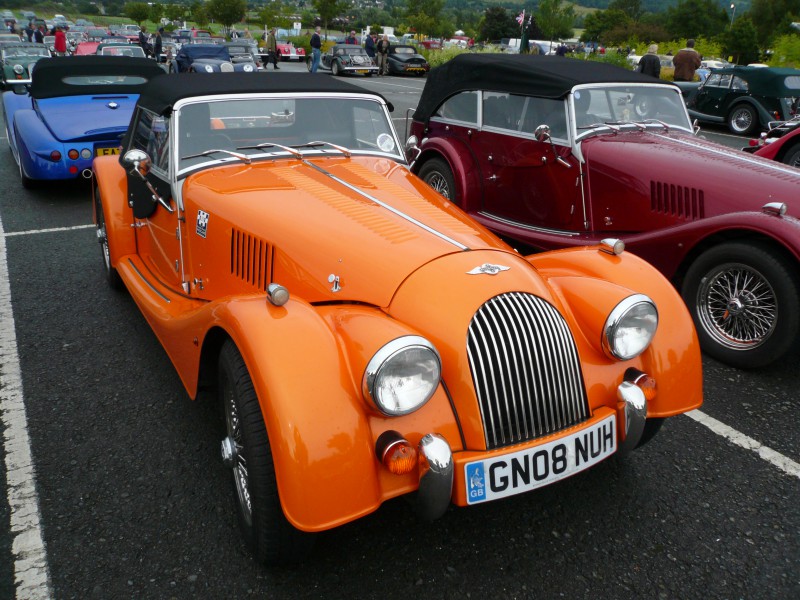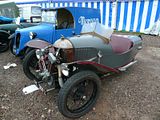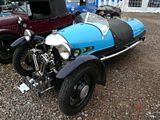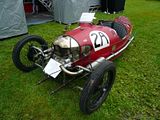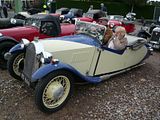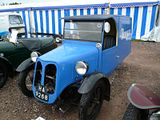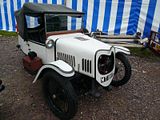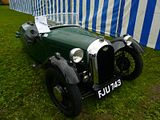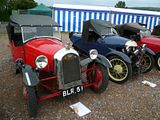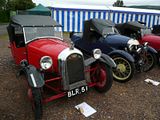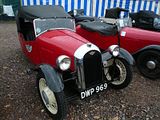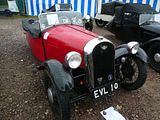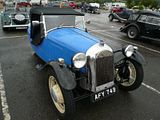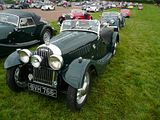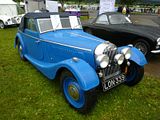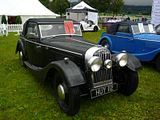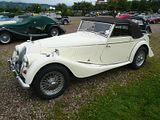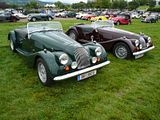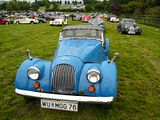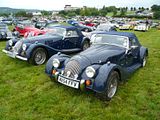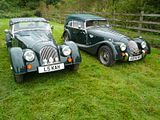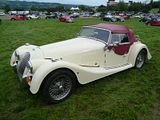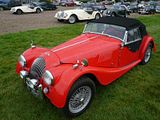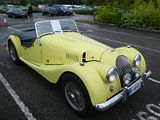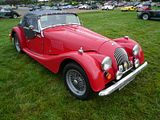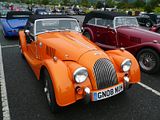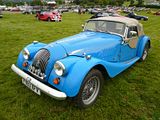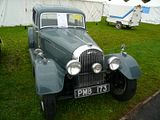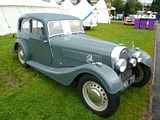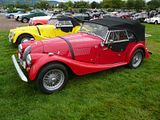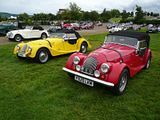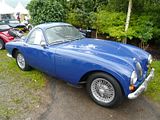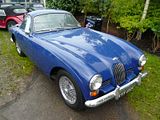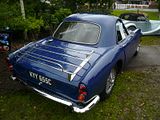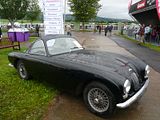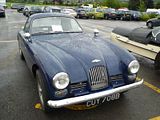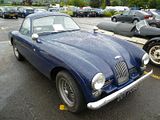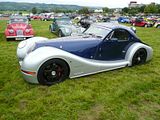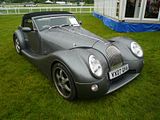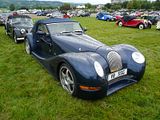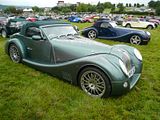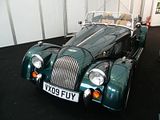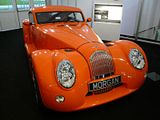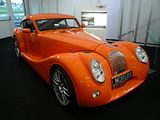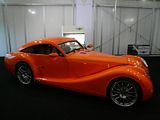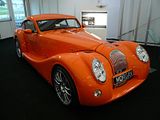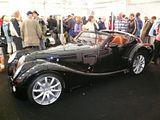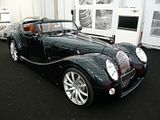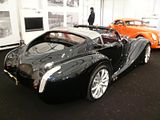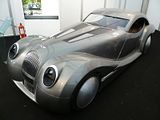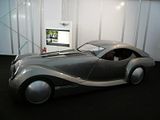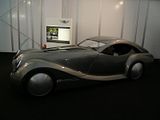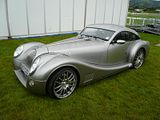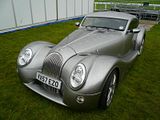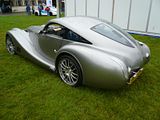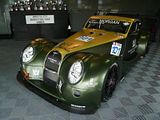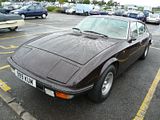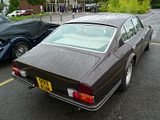There are very few car manufacturers that are not just British owned, but still in the same family as when they were founded. One of the few is celebrating its centenary: Morgan Cars. A week’s program of events culminates in a 2 day Festival at Cheltenham Racecourse and I have just braved the weather to go and see what was billed as one of the largest gatherings of Morgans that the world has ever seen. Certainly the weather had to be braved, as it was truly revolting when I set off from home, but the forecast did suggest that the rain would cease during the afternoon and that there might even be a touch of sun poking through the clouds. Morgan owners are generally hardy, so I expected that despite this rather unfortunate prognosis, there would doubtless be a good showing. And there was. Cars from every Western European country, America, Canada and possibly other places as well covered most of the main parking areas at the Racecourse, some taking shelter under their tonneau covers or make shift tarpaulins, others still open to the elements. It did rain. Hard. But eventually it stopped, and I was able to revel in this quintessentially British sports carThis is a replica of the very first Morgan, built in 1909. The idea to construct such a car was hatched as far back as 2001, but it was only a few months ago that the car was finished. There were few photos and certainly no engineering drawings on which to base the project, but it does feature a genuine Peugeot engine from 1906 and some of the other parts were sourced from places like the Beaulieu Autojumble.
Early Morgans are famous for being three wheeled, with two front wheels and a single rear wheel, and for featuring JAP motorcycle engines mounted up front. There were several such cars for us all to admire.
During the 1920s and 1930s, Morgan tried to expand their potential market by making available features to appeal to the family, and some of these cars were also included in the displays.
The 4 wheel design that emerged in the 1930s has formed the basis for the range ever since that time. There have clearly been lots of mechanical changes, with a bewildering array of engines from various donor companies over the years but the basic style has changed not much. You can see examples of this in these cars.
These are from the 1950s.
This one is from the very early 1960s
These are the more recent Plus 4 and Plus 8 cars.
This 1952 car was fitted with a special saloon body, as a few cars were at the time.
There has almost always been a 4 seater car in the range, and these cars are very easy to identify when the roof is up as was the case today.
In 1963, Morgan did try an experiment with a very different car, the Plus Four Plus, a fully enclosed sports car. It was not a success and only 26 were made. It is believed that 8 are in the UK and 3 of them were in attendance.
When the Aero was first shown, there were howls of protest from the traditionalists. But now it is an accepted part of the model range, and there were many of these cars at the event, as you would expect.
Morgan Cars had their own display area, with examples of the current range on show, and salesmen on hand in case anyone should want to place an order.
This Aeromax, one of the last of the series of 100 cars to be produced, is destined for Saudi Arabia, I learned.
The 2010 “limited edition” car, also with only 100 to be produced, will start production soon. There are already orders for 80 of them.
This is the Life car which was shown at Geneva 2009, and presages the use of some advanced technology to reduce the emissions levels considerably.
There was another Aeromax parked up outside the factory display area.
Morgan also has a long and successful track record in motor sport, and the latest cars have allowed them to compete among the “big boys” all the way up to le Mans.
A fascinating display showed how a modern Aeromax is created. It still starts with a wooden frame. Despite all the naysayers from the safety lobby, Morgan’s tests show that this is as strong as a metal base, and now that they use Cuprinol wood preserver (something they only started doing about 20 years ago!), the wood should last. The body is made from aluminium, using a technique called “superforming”, which was a world first when Morgan introduced it. Most of the mechanical components are from BMW and are assembled into a rolling chassis, which is then introduced to the body before final trim and assembly. The complete process takes about 8 – 9 weeks per car.
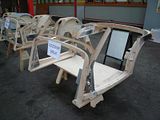
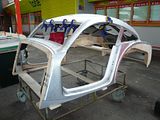
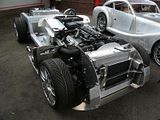
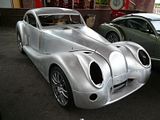
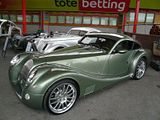 Although most of the hard-standing parking was dedicated to Morgans (the rest of us had to park on the grass and mud), this rather splendid Monica was parked up. Who could begrudge such a rare machine a prominent position. It was interesting listening to people coming up to look at it, that hardly anyone seemed to know what it was.
Although most of the hard-standing parking was dedicated to Morgans (the rest of us had to park on the grass and mud), this rather splendid Monica was parked up. Who could begrudge such a rare machine a prominent position. It was interesting listening to people coming up to look at it, that hardly anyone seemed to know what it was.
Some years ago, the late Sir John Harvey Jones presented a series of tv programs called “Troubleshooter” where he examined a number of British companies and provided his own (usually critical) assessment of each firm. He was particularly damning of what he found when he went to Malvern Link, castigating them for old-fashioned production methods and for the once legendary 6 – 8 year lead time for deliveries. Undeterred, Morgan carried on pretty much ignoring his suggestions. It is wonderful, therefore, to see a company producing cars that now sell well around the world, full of confidence for the future. Let’s raise a glass to Morgan and wish them well for their second century!

